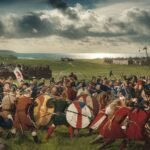
The image of Viking berserkers has captivated imaginations for centuries. These fierce warriors, known for their uncontrollable rage and superhuman strength in battle, have become legendary figures in Norse mythology and popular culture. But what is the truth behind these frenzied fighters?
Origins
The term “berserker” comes from the Old Norse words “berserkr,” meaning “bear shirt” or “bearskin”. This name likely refers to the animal skins these warriors wore into battle, often bear or wolf pelts. The concept of berserkers dates back to the Viking Age, roughly from 793 to 1066 CE, when Norse warriors raided and settled various parts of Europe, including Ireland.
While berserkers have become legendary figures, there is historical evidence supporting their existence from the Annals of Ulster, a medieval Irish chronicle, which mentions Viking warriors exhibiting berserker-like behavior. Numerous Norse sagas describe berserkers and their feats, while a 12th-century chess piece found on the Isle of Lewis depicts a warrior biting his shield, a characteristic associated with berserkers.

Chess piece from the Isle of Lewis, Scotland, showing a warrior in ‘beserker frenzy’
The Berserker’s Battle Frenzy
The most distinctive characteristic of berserkers was their legendary battle frenzy, known as “berserkergangr”. According to historical accounts, these warriors would work themselves into a trance-like state before combat. Fired up, they were said to possess incredible ferocity and fearlessness. During these battle frenzies, the berserkers would attack their enemies with reckless abandon, feeling no pain and continuing to fight even after suffering severe injuries.
Nordic annals give descriptions of berserkers in battle that are both awe-inspiring and terrifying: they would howl like wild beasts and foam at the mouth, gnawed the rims of their shields, could allegedly attack boulders and trees in their frenzy, and some accounts suggest they might even turn on their own comrades in their battle-lust.
Berserkers in action

Thorbjorn “Bear-Tooth” Ulfsson, a renowned Viking berserker, took part in a fierce battle in 852 CE during a raid on the Irish monastery at Clonmacnoise. Known for his ferocity and trance-like state during combat, Thorbjorn was among the elite warriors who served under King Harald Fairhair. As the Vikings approached the shore, Thorbjorn prepared himself for battle by entering the berserkergangr, a state of uncontrollable rage and strength.
With his bear pelt draped over his shoulders, Thorbjorn charged into the fray, seemingly impervious to pain and injury. Arrows and blows that would fell ordinary men seemingly glanced off him as he waded through the Irish defenders. His eyes burned with an intense fury, and he howled like a wild beast, striking terror into the hearts of his enemies.
Thorbjorn’s axe cleaved through shields and armor with ease, each swing leaving a trail of destruction. His fellow Vikings, inspired by his fearlessness, surged forward to join the assault. The Irish defenders, overwhelmed by the ferocity of Thorbjorn and his comrades, eventually broke ranks and fled.
The battle ended in victory for the Vikings, with Thorbjorn’s exploits becoming legendary. His actions that day exemplified the terrifying might of Viking berserkers, whose trance-like fury made them formidable foes on the battlefield.
Theories on the Berserker State
While the legends of berserkers are captivating, historians have proposed several theories to explain the reality behind their famed battle frenzy:
Psychological Warfare
One theory suggests that the berserker state was a form of self-hypnosis or psychological warfare. By working themselves into a frenzy, these warriors could intimidate their enemies and boost the morale of their fellow Vikings.
Hallucinogenic Substances

Another popular theory is that berserkers used hallucinogenic substances to induce their trance-like state. Certainly psilocybin mushrooms, now commonly known as magic mushrooms, were well known in Dark Age Europe. Recent research has proposed that they may have consumed henbane, a plant with psychoactive properties. Henbane’s effects better match the described berserker state compared to other proposed substances.
Religious Devotion
Berserkers were closely associated with the Norse god Odin. Some scholars believe their battle frenzy was a form of religious ecstasy, with warriors channeling the spirit of Odin in combat. The Icelandic Ynglinga Saga describes berserkers and their relationship to Odin:
“Óðinn could bring it about that in battle his opponents were struck with blindness or deafness or panic, and their weapons would cut no better than sticks, while his men went without mail and were as wild as dogs or wolves, biting their shields, being as strong as bears or bulls. They killed the people, but neither fire nor iron took effect on them. They are called berserkers”.
The Decline of Berserkers
As Viking society evolved and Christianity spread through Scandinavia, the role of berserkers diminished. By the 12th century, berserkers were increasingly viewed as dangerous and unpredictable, leading to their eventual outlawing in some Norse communities.




